Sabine Süsstrunk
Canonical Latent Representations in Conditional Diffusion Models
Jun 11, 2025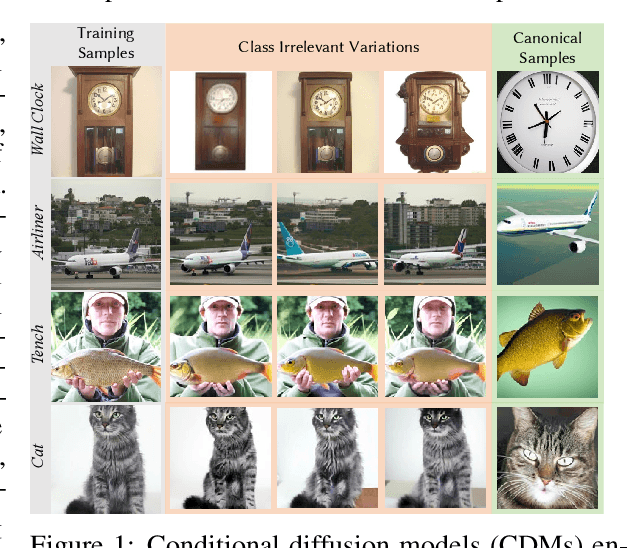
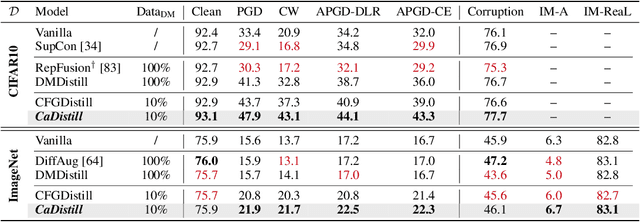


Abstract:Conditional diffusion models (CDMs) have shown impressive performance across a range of generative tasks. Their ability to model the full data distribution has opened new avenues for analysis-by-synthesis in downstream discriminative learning. However, this same modeling capacity causes CDMs to entangle the class-defining features with irrelevant context, posing challenges to extracting robust and interpretable representations. To this end, we identify Canonical LAtent Representations (CLAReps), latent codes whose internal CDM features preserve essential categorical information while discarding non-discriminative signals. When decoded, CLAReps produce representative samples for each class, offering an interpretable and compact summary of the core class semantics with minimal irrelevant details. Exploiting CLAReps, we develop a novel diffusion-based feature-distillation paradigm, CaDistill. While the student has full access to the training set, the CDM as teacher transfers core class knowledge only via CLAReps, which amounts to merely 10 % of the training data in size. After training, the student achieves strong adversarial robustness and generalization ability, focusing more on the class signals instead of spurious background cues. Our findings suggest that CDMs can serve not just as image generators but also as compact, interpretable teachers that can drive robust representation learning.
VibrantLeaves: A principled parametric image generator for training deep restoration models
Apr 14, 2025



Abstract:Even though Deep Neural Networks are extremely powerful for image restoration tasks, they have several limitations. They are poorly understood and suffer from strong biases inherited from the training sets. One way to address these shortcomings is to have a better control over the training sets, in particular by using synthetic sets. In this paper, we propose a synthetic image generator relying on a few simple principles. In particular, we focus on geometric modeling, textures, and a simple modeling of image acquisition. These properties, integrated in a classical Dead Leaves model, enable the creation of efficient training sets. Standard image denoising and super-resolution networks can be trained on such datasets, reaching performance almost on par with training on natural image datasets. As a first step towards explainability, we provide a careful analysis of the considered principles, identifying which image properties are necessary to obtain good performances. Besides, such training also yields better robustness to various geometric and radiometric perturbations of the test sets.
VGRP-Bench: Visual Grid Reasoning Puzzle Benchmark for Large Vision-Language Models
Apr 02, 2025
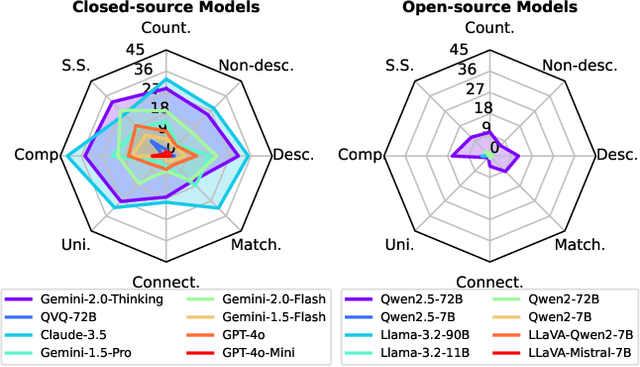
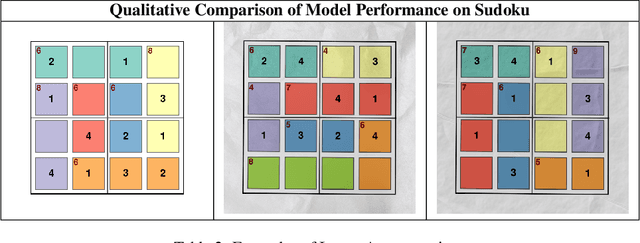
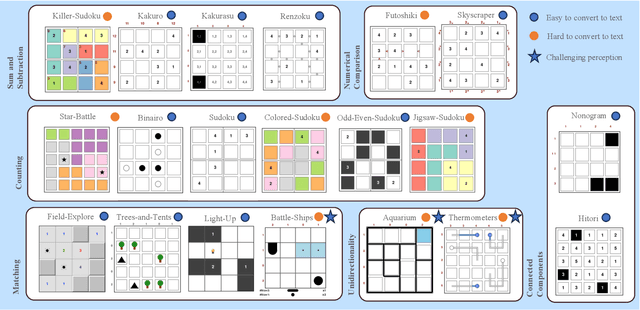
Abstract:Large Vision-Language Models (LVLMs) struggle with puzzles, which require precise perception, rule comprehension, and logical reasoning. Assessing and enhancing their performance in this domain is crucial, as it reflects their ability to engage in structured reasoning - an essential skill for real-world problem-solving. However, existing benchmarks primarily evaluate pre-trained models without additional training or fine-tuning, often lack a dedicated focus on reasoning, and fail to establish a systematic evaluation framework. To address these limitations, we introduce VGRP-Bench, a Visual Grid Reasoning Puzzle Benchmark featuring 20 diverse puzzles. VGRP-Bench spans multiple difficulty levels, and includes extensive experiments not only on existing chat LVLMs (e.g., GPT-4o), but also on reasoning LVLMs (e.g., Gemini-Thinking). Our results reveal that even the state-of-the-art LVLMs struggle with these puzzles, highlighting fundamental limitations in their puzzle-solving capabilities. Most importantly, through systematic experiments, we identify and analyze key factors influencing LVLMs' puzzle-solving performance, including the number of clues, grid size, and rule complexity. Furthermore, we explore two Supervised Fine-Tuning (SFT) strategies that can be used in post-training: SFT on solutions (S-SFT) and SFT on synthetic reasoning processes (R-SFT). While both methods significantly improve performance on trained puzzles, they exhibit limited generalization to unseen ones. We will release VGRP-Bench to facilitate further research on LVLMs for complex, real-world problem-solving. Project page: https://yufan-ren.com/subpage/VGRP-Bench/.
FDS: Frequency-Aware Denoising Score for Text-Guided Latent Diffusion Image Editing
Mar 24, 2025



Abstract:Text-guided image editing using Text-to-Image (T2I) models often fails to yield satisfactory results, frequently introducing unintended modifications, such as the loss of local detail and color changes. In this paper, we analyze these failure cases and attribute them to the indiscriminate optimization across all frequency bands, even though only specific frequencies may require adjustment. To address this, we introduce a simple yet effective approach that enables the selective optimization of specific frequency bands within localized spatial regions for precise edits. Our method leverages wavelets to decompose images into different spatial resolutions across multiple frequency bands, enabling precise modifications at various levels of detail. To extend the applicability of our approach, we provide a comparative analysis of different frequency-domain techniques. Additionally, we extend our method to 3D texture editing by performing frequency decomposition on the triplane representation, enabling frequency-aware adjustments for 3D textures. Quantitative evaluations and user studies demonstrate the effectiveness of our method in producing high-quality and precise edits.
Noise Synthesis for Low-Light Image Denoising with Diffusion Models
Mar 14, 2025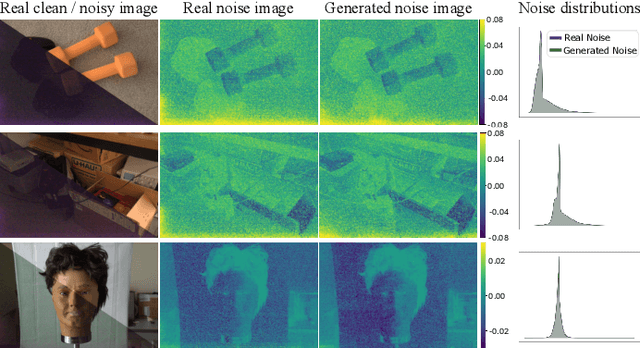

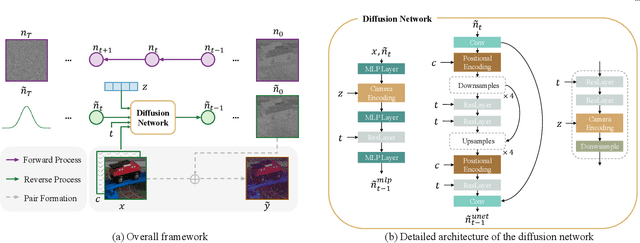

Abstract:Low-light photography produces images with low signal-to-noise ratios due to limited photons. In such conditions, common approximations like the Gaussian noise model fall short, and many denoising techniques fail to remove noise effectively. Although deep-learning methods perform well, they require large datasets of paired images that are impractical to acquire. As a remedy, synthesizing realistic low-light noise has gained significant attention. In this paper, we investigate the ability of diffusion models to capture the complex distribution of low-light noise. We show that a naive application of conventional diffusion models is inadequate for this task and propose three key adaptations that enable high-precision noise generation without calibration or post-processing: a two-branch architecture to better model signal-dependent and signal-independent noise, the incorporation of positional information to capture fixed-pattern noise, and a tailored diffusion noise schedule. Consequently, our model enables the generation of large datasets for training low-light denoising networks, leading to state-of-the-art performance. Through comprehensive analysis, including statistical evaluation and noise decomposition, we provide deeper insights into the characteristics of the generated data.
Unlocking Comics: The AI4VA Dataset for Visual Understanding
Oct 27, 2024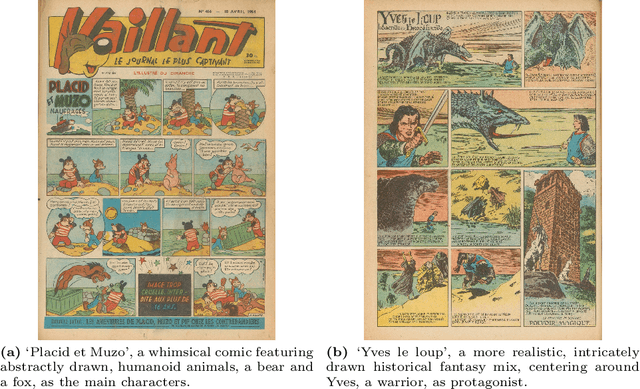
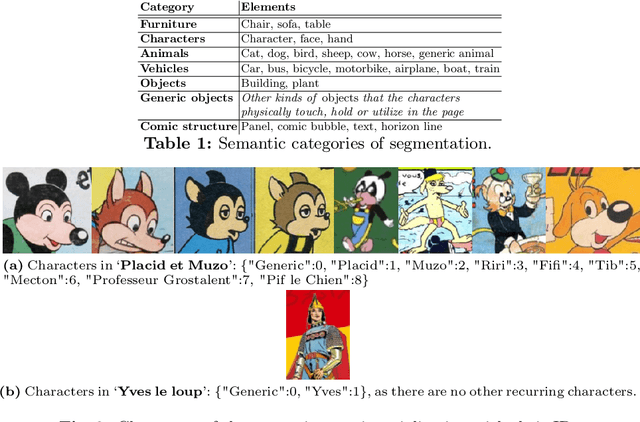
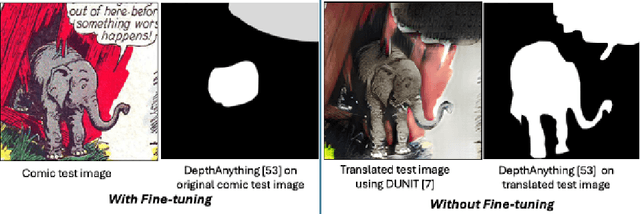

Abstract:In the evolving landscape of deep learning, there is a pressing need for more comprehensive datasets capable of training models across multiple modalities. Concurrently, in digital humanities, there is a growing demand to leverage technology for diverse media adaptation and creation, yet limited by sparse datasets due to copyright and stylistic constraints. Addressing this gap, our paper presents a novel dataset comprising Franco-Belgian comics from the 1950s annotated for tasks including depth estimation, semantic segmentation, saliency detection, and character identification. It consists of two distinct and consistent styles and incorporates object concepts and labels taken from natural images. By including such diverse information across styles, this dataset not only holds promise for computational creativity but also offers avenues for the digitization of art and storytelling innovation. This dataset is a crucial component of the AI4VA Workshop Challenges~\url{https://sites.google.com/view/ai4vaeccv2024}, where we specifically explore depth and saliency. Dataset details at \url{https://github.com/IVRL/AI4VA}.
Data Augmentation via Latent Diffusion for Saliency Prediction
Sep 11, 2024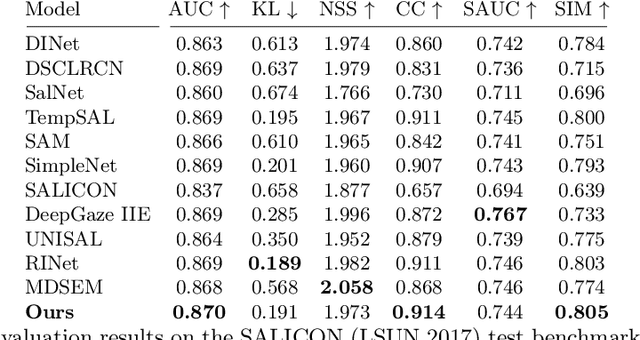
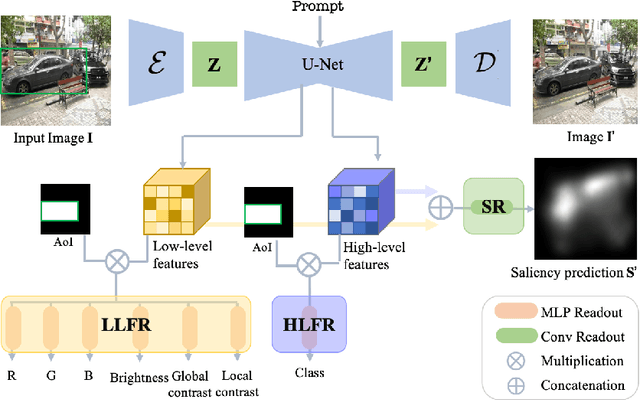
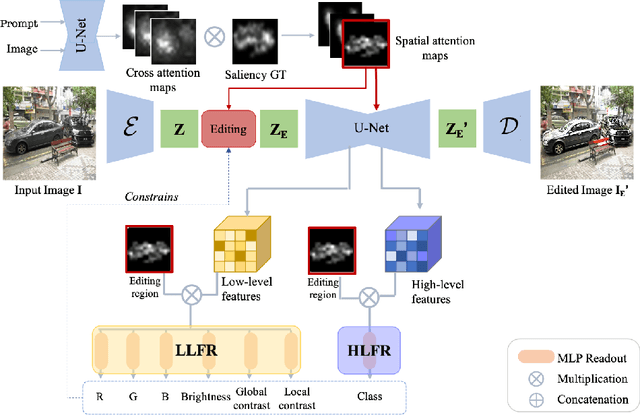
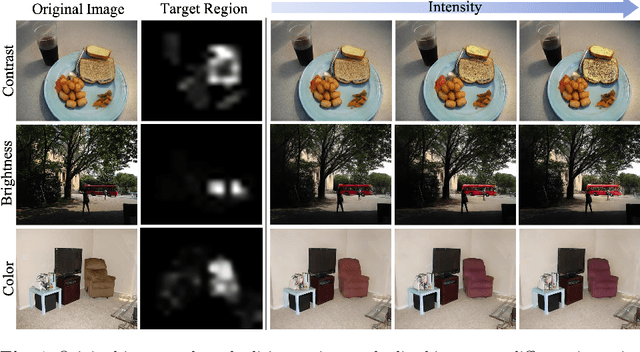
Abstract:Saliency prediction models are constrained by the limited diversity and quantity of labeled data. Standard data augmentation techniques such as rotating and cropping alter scene composition, affecting saliency. We propose a novel data augmentation method for deep saliency prediction that edits natural images while preserving the complexity and variability of real-world scenes. Since saliency depends on high-level and low-level features, our approach involves learning both by incorporating photometric and semantic attributes such as color, contrast, brightness, and class. To that end, we introduce a saliency-guided cross-attention mechanism that enables targeted edits on the photometric properties, thereby enhancing saliency within specific image regions. Experimental results show that our data augmentation method consistently improves the performance of various saliency models. Moreover, leveraging the augmentation features for saliency prediction yields superior performance on publicly available saliency benchmarks. Our predictions align closely with human visual attention patterns in the edited images, as validated by a user study.
Controlling the Fidelity and Diversity of Deep Generative Models via Pseudo Density
Jul 11, 2024



Abstract:We introduce an approach to bias deep generative models, such as GANs and diffusion models, towards generating data with either enhanced fidelity or increased diversity. Our approach involves manipulating the distribution of training and generated data through a novel metric for individual samples, named pseudo density, which is based on the nearest-neighbor information from real samples. Our approach offers three distinct techniques to adjust the fidelity and diversity of deep generative models: 1) Per-sample perturbation, enabling precise adjustments for individual samples towards either more common or more unique characteristics; 2) Importance sampling during model inference to enhance either fidelity or diversity in the generated data; 3) Fine-tuning with importance sampling, which guides the generative model to learn an adjusted distribution, thus controlling fidelity and diversity. Furthermore, our fine-tuning method demonstrates the ability to improve the Frechet Inception Distance (FID) for pre-trained generative models with minimal iterations.
Coherent and Multi-modality Image Inpainting via Latent Space Optimization
Jul 10, 2024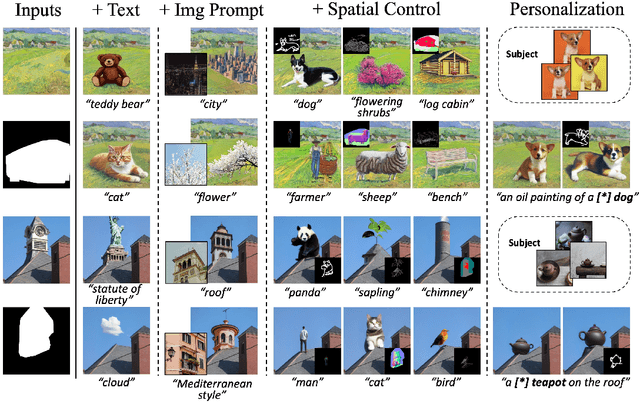

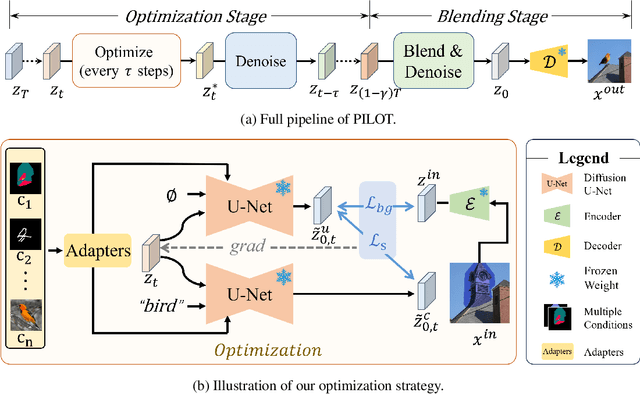

Abstract:With the advancements in denoising diffusion probabilistic models (DDPMs), image inpainting has significantly evolved from merely filling information based on nearby regions to generating content conditioned on various prompts such as text, exemplar images, and sketches. However, existing methods, such as model fine-tuning and simple concatenation of latent vectors, often result in generation failures due to overfitting and inconsistency between the inpainted region and the background. In this paper, we argue that the current large diffusion models are sufficiently powerful to generate realistic images without further tuning. Hence, we introduce PILOT (in\textbf{P}ainting v\textbf{I}a \textbf{L}atent \textbf{O}p\textbf{T}imization), an optimization approach grounded on a novel \textit{semantic centralization} and \textit{background preservation loss}. Our method searches latent spaces capable of generating inpainted regions that exhibit high fidelity to user-provided prompts while maintaining coherence with the background. Furthermore, we propose a strategy to balance optimization expense and image quality, significantly enhancing generation efficiency. Our method seamlessly integrates with any pre-trained model, including ControlNet and DreamBooth, making it suitable for deployment in multi-modal editing tools. Our qualitative and quantitative evaluations demonstrate that PILOT outperforms existing approaches by generating more coherent, diverse, and faithful inpainted regions in response to provided prompts.
AdaNCA: Neural Cellular Automata As Adaptors For More Robust Vision Transformer
Jun 12, 2024Abstract:Vision Transformers (ViTs) have demonstrated remarkable performance in image classification tasks, particularly when equipped with local information via region attention or convolutions. While such architectures improve the feature aggregation from different granularities, they often fail to contribute to the robustness of the networks. Neural Cellular Automata (NCA) enables the modeling of global cell representations through local interactions, with its training strategies and architecture design conferring strong generalization ability and robustness against noisy inputs. In this paper, we propose Adaptor Neural Cellular Automata (AdaNCA) for Vision Transformer that uses NCA as plug-in-play adaptors between ViT layers, enhancing ViT's performance and robustness against adversarial samples as well as out-of-distribution inputs. To overcome the large computational overhead of standard NCAs, we propose Dynamic Interaction for more efficient interaction learning. Furthermore, we develop an algorithm for identifying the most effective insertion points for AdaNCA based on our analysis of AdaNCA placement and robustness improvement. With less than a 3% increase in parameters, AdaNCA contributes to more than 10% absolute improvement in accuracy under adversarial attacks on the ImageNet1K benchmark. Moreover, we demonstrate with extensive evaluations across 8 robustness benchmarks and 4 ViT architectures that AdaNCA, as a plug-in-play module, consistently improves the robustness of ViTs.
 Add to Chrome
Add to Chrome Add to Firefox
Add to Firefox Add to Edge
Add to Edge